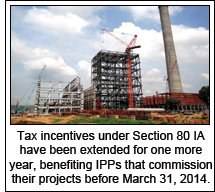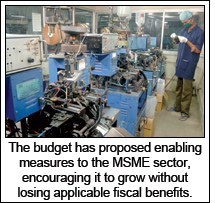
Union finance minister P. Chidambaram definitely had
the struggling power T&D sector in mind when he
presented his Budget 2013 on February 28, 2013. Even
if there was no open mention of measures in his budget speech
to boost the power T&D sector, the detailed budget
documents throw a pleasant surprise to the contrary.
The total plan outlay for the power sector for FY14 is
estimated at Rs.10,073 crore that is a significant 27 per cent
higher than the revised estimate of Rs.7,902 crore for FY13.
The good news does not end here. While the proportion of
plan expenditure (synonymous with capital expenditure) in
the total outlay was 59 per cent in FY13, that for FY14 is a
whopping 96 per cent. In other words, this implies that the
business opportunity available to power equipment vendors
and service providers will be roughly double the level in FY13.
The Budget is very serious about reforms in the power
distribution sector, which is the inviolate precursor to techno commercial
efficiency in the power value chain. In his budget
speech, the finance minister exhorted state governments to
financially restructure their beleaguered utilities in line with
the restructuring scheme already approved by the
government last year. "I would urge state governments to
prepare the financial restructuring plans quickly, sign the
MOU, and take advantage of the scheme," was what
Chidambaram said in a strikingly serious tone. The budget
has set aside Rs.1,500 crore as financial support for debt
restructuring of distribution utilities in FY14. However, only
a few state governments have so far opted for restructuring
under the said scheme.

The overall plan outlay for the power T&D sector for FY14
is Rs.9,049 crore that is more than twice the level of Rs.4,280
crore in FY13. Apart from Rs.1,500 crore apportioned for the
discom debt restructuring, the budget has made a generous
provision of Rs.4,041 crore for subsidizing rural
electrification works under RGGYY in FY14, as against
Rs.2,002 crore in FY13.
Public sector units under the power ministry are
expected to maintain their capital expenditure levels
in FY14. The total capex by power PSUs is
estimated to be Rs.51,264 crore in FY14 as against
Rs.50,841 crore in FY13. Central transmission
utility Power Grid Corporation of India will
incur Rs.20,000 crore of capex in FY14, same
as that in FY13. For the XII Plan, PGCIL is
expected to spend Rs.1 lakh crore as
capital expenditure as against some
Rs.55,000 crore in the XI Plan period.
The budget formalized a very
important power transmission
project in Jammu & Kashmir. A
220kV Leh-Kargil transmission
system has been
proposed to improve power supply
in the Leh-Kargil region and to connect
Ladakh region to the northern grid. Costing
Rs.1,840 crore, this transmission line will
traverse an estimated 400 km. For FY14, the budget
has made a provision of Rs.226 crore on the project that will be executed by Power Grid Corporation of India Ltd. The
project, which has been in the planning stage for at least six
years now, is expected to see traction in FY14. Industry
experts believe that this transmission line, to be built at an
altitude of over 10,000 ft and in hostile climate, will be the
toughest project for PGCIL in India.
 COAL & POWER
COAL & POWER
The Budget clearly acknowledged the apprehension that
India will face coal shortages in the coming years. While much
is being done to promote renewable energy (non-fossil) power
generation, the dependence on coal cannot be wished away.
The Budget has proposed to adopt the PPP framework, with
Coal India Ltd being one of the partners, to boost domestic
production. The move is very significant as it comes at a time
when CIL is consistently failing to meet its production
targets, and dependence on imported coal is rising. As against
the target of 464.10 million tonnes for 2012-13, actual output
by Coal India Ltd is likely to be 451.50 million tonnes, which
would imply a shortfall of 12.6 million tonnes. India's coal
imports in the first three quarters of 2012-13 have already
crossed 100 million tonnes and by 2016-17, they are estimated
to grow to 185 million tonnes. Domestic coal shortages are
not only affecting regular operations of existing thermal
power plants but delays in receiving coal linkages are
hindering the progress of upcoming generating stations.
The budget also ironed out the disparities in import duties
between steam coal and bituminous coal. Both the variants
will now have a uniform customs duty of 2 per cent and a
countervailing duty of 2 per cent. While this has brought
about uniformity as far as calculation of customs duty is
concerned, companies relying on imported steam coal will
now face higher landed costs. In conjunction with the hike
freight charges as envisaged in the Railway Budget, the cost of
power generation can potentially go up by around Rs.0.07 per
unit.
The budget has also extended tax benefits available to
power producers under Section 80-IA for one more year. This
is expected to encourage more capacity addition in the power
sector by March 2014. According to information available, power generation capacity of around 14,600 mw is scheduled
for commissioning during 2013-14. These projects can now
avail tax benefits for the first ten years of their operation.
 ELECTRICAL EQUIPMENT
ELECTRICAL EQUIPMENT
The electrical equipment industry is generally disappointed
due to the absence of direct positive-impact measures.
Industry association IEEMA was expecting some measures to
counter the downturn in the electrical equipment industry. In
a statement, J.G. Kulkarni, President, IEEMA, noted that the
association was hopeful of some favourable announcements
in the budget for countering increasing imports of electrical
equipment. It was also expected that service tax exemption
would be granted to all projects covered in power generation,
transmission and distribution in line with exemption
provided to other infrastructure development projects.
It may be mentioned that the long-standing demand of a
level-playing field between domestic and imported electrical
equipment was somewhat addressed by the government
earlier this year when it imposed a countervailing duty of 14
per cent on imported power equipment. All the same,
imported power equipment still holds a duty-related
advantage—albeit now reduced—over domestic production.
RENEWABLE ENERGY
As widely anticipated, the Union Budget restored the
generation based incentive (GBI) available to wind power
projects and made an allocation of Rs.800 crore towards this
cause. Wind energy has been the backbone of India's
renewable energy pursuits. In less than three years—FY11,
FY12 and FY13 (up to January 31, 2013)—India could add a
record 12,436 mw of grid-connected renewable energy
capacity, according to official figures released by the
government, with wind energy contributing a healthy 67 per
cent. All the same, the pace of wind energy capacity addition
had dropped perceptibly when the GBI scheme was repealed.
In 2011-12, while India saw over 3 GW of new wind power
capacity coming online, the addition plummeted to around
1.5 GW in 2012-13. With the GBI scheme now restored, it is
expected that projects worth 1 GW or so, which were facing
uncertain prospects, might now come on stream in the next 1-
2 years.
The budget also envisaged a scheme encouraging
municipalities and cities to convert municipal solid waste to
energy. The scheme, to be implemented on PPP basis, will be
neutral to different technologies. The budget promised
support to project implementing agencies (municipalities,
urban local bodies, etc) with different financial instruments
like viability gap funding, repayable grant, access to low-cost
capital, etc.
Currently, India does have a few MSW-based power
generation projects in the private sector. However, they suffer
from high generation costs and are not commercially viable
without government support. India is urbanizing at an
alarming rate. The 2011 Census put India's urbanization at
31.2 per cent and this is expected to touch around 40 per cent
by 2030. MSW-based power projects are an excellent means
to put growing amount of solid waste to gainful use.
The budget has also acknowledged that Indian consumers
end up paying more for renewable energy-based generation,
partly because of high cost of finance. With a view to
providing low-cost finance, the government will provide lowinterest
bearing funds from the National Clean Energy Fund
(NCEF) to IREDA to on-lend to viable renewable energy
projects. The scheme will have a life span of five years.
 MICRO & SME SECTOR
MICRO & SME SECTOR
Despite the fact that there were no direct measures to boost
the electrical equipment industry, the finance minister has
attempted some "backward integration" where he has put out
a sincere attempt to galvanize the micro & small medium
enterprise (MSME) sector through some radical measures.
Given that the MSME sector forms the backbone of the
electrical equipment industry, these announcements do hold
out promise.
P. Chidambaram made a very telling observation on the psychology of MSME sector companies. "Too many of them
do not grow because of the fear of losing the benefits
associated with staying small or medium," the minister said.
To foster growth in the MSME sector, the budget proposed
that benefits or preferences enjoyed by them will stay with
them for up to three years after they grow out of the category
in which they obtained the benefit.
The budget also proposed to enhance the refinancing
capability of SIDBI from the current level of Rs.5,000 crore to
Rs.10,000 crore per year so as to cater to a growing fraternity
of MSME companies.
Tool Rooms & Technology Development Centres set up by
the Ministry of Micro, Small and Medium Enterprises have
done well in extending technology and design support to
small businesses. The budget has proposed to provide, with
World Bank assistance, a sum of Rs.2,200 crore during the XII
Plan period to set up 15 additional centres.
RETURN OF INVESTMENT ALLOWANCE
This year's budget sought to revive the practice of "investment
allowance" that existed in the late 1980s and the early 1990s.
Budget 2013 proposed to introduce investment allowance for
new high value investments. A company investing Rs.100
crore or more in plant and machinery during the period April
1, 2013 to March 31, 2015 will be entitled to deduct an
investment allowance of 15 per cent of the investment. This
will be in addition to the current rates of depreciation. "There
will be enormous spill-over benefits to small and medium
enterprises," noted the finance minister.
SEMICONDUCTORS
The budget has proposed to provide "appropriate incentives"
to semiconductor wafer fab manufacturing facilities. These
incentives include zero customs duty for plant and
machinery. These incentives will become part of the National
Electronics Policy 2012 that aims at promoting manufacture
of electronics goods in India.
 THE OVERALL INFRA PUSH
THE OVERALL INFRA PUSH
The electrical equipment sector has a last-mile connection
with general infrastructure development. Hence, overall
measures to boost infrastructure development will always
have a positive bearing on the industry. The budget has
consciously kept up the infrastructure momentum with a
focus on removing policy bottlenecks and alleviating
financing constraints.
In his presentation, Union finance minister P.
Chidambaram was unambiguous of the need to not only
sustain but also accelerate the pace of India's infrastructure
development. "The key to restart the growth engine is to
attract more investment, both from domestic investors and
foreign investors," the finance minister noted and
supplemented it by observing, "while every sector can absorb
new investment, it is the infrastructure sector that needs large
volumes of investment."
The XII Plan period (2012-13 to 2016-17) needs an
estimated $1 trillion (Rs.55 trillion) of investment out of
which the private sector's contribution would be an envisaged
47 per cent. The Budget underscored the need for effective
means of financing and envisaged greater support to
infrastructure debt funds. These funds, four of which have
already been registered, will raise resources and, through
takeout finance, credit enhancement and other innovative
means, provide long-term and low-cost debt to infrastructure
projects. The Budget also stated that India Infrastructure
Finance Corporation Ltd (IIFCL), in partnership with Asian
Development Bank, will offer credit enhancement to
infrastructure companies that wish to access the bond market
to tap long term funds.
Mobilisation from tax-free bonds by financial institutions
is expected to be around Rs.25,000 crore in FY13 as against
Rs.30,000 crore in FY12. The decline perhaps reflects the
withdrawal of income tax incentives available to retail
investors. Nevertheless, the Budget has provided for up to
Rs.50,000 crore to be raised through infrastructure bonds
albeit "strictly based on the need and capacity to raise money
in the market."